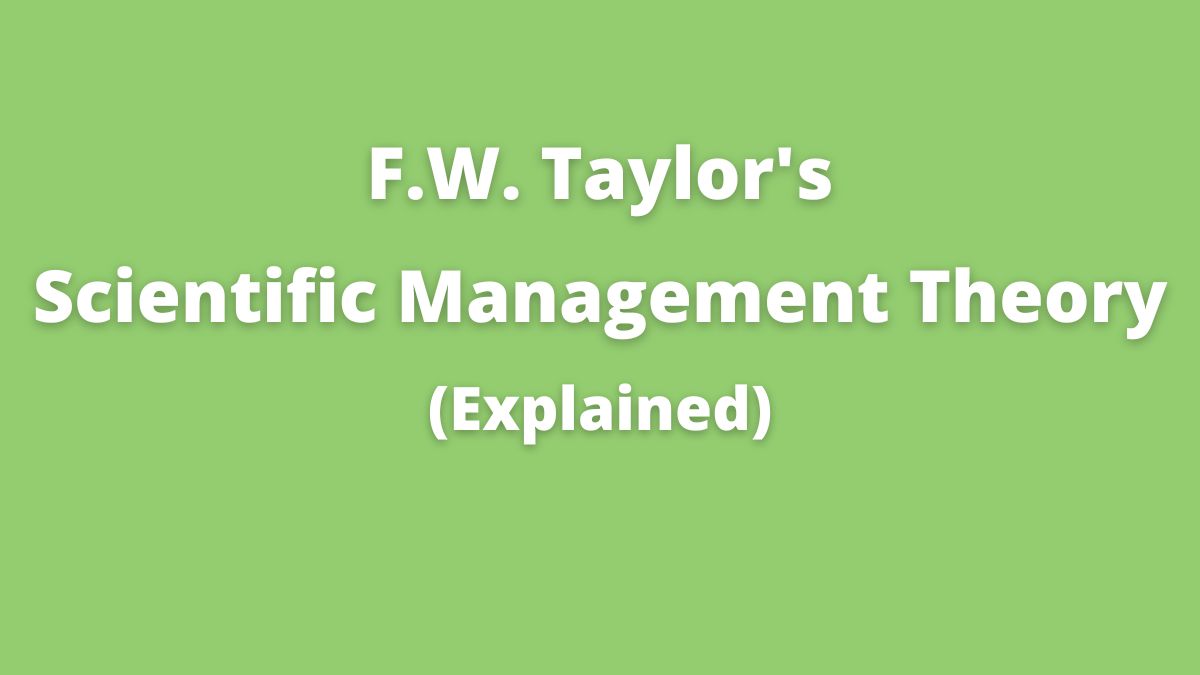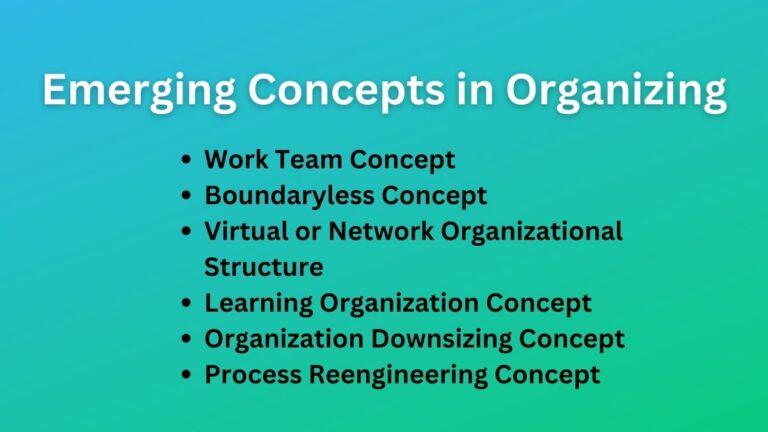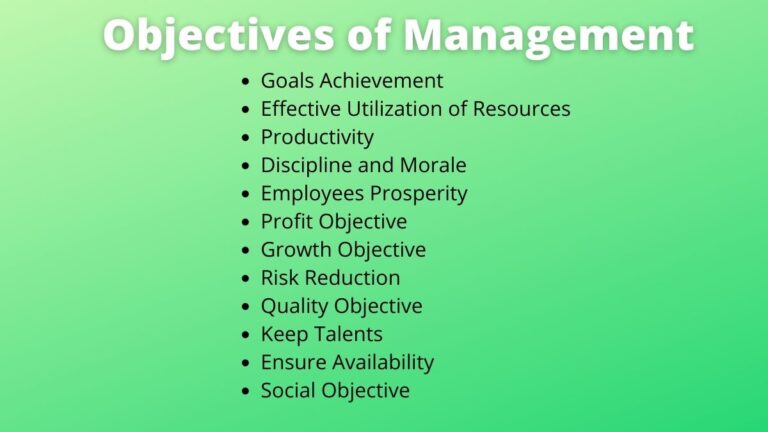F.W. Taylor’s Scientific Management Theory: Definition, History, Principles, Contribution, and Limitation
What is Scientific Management Theory?
Scientific management theory is the means of improving efficiency and productivity in the organization. It emphasizes using of different scientific tools to improve employees’ efficiency and productivity of the organization as a whole.
This theory is by Fredrick Winslow Taylor (1856-1915), an industrial engineer whose goal was to apply his scientific principles (methods) in the management of businesses.
Scientific methods are the results of thorough observation, analysis, and experiment. By which managers can observe their organization, experiment with different ways of completing tasks, and analyze the likely consequences that they will bring.
Scientific management follows the bottom-up approach meaning that it first aims to increase the efficiency of lower workers of the business believing later it will support the overall organizational efficiency.
Scientific management theory is focused on improving the efficiency of workers in routine tasks. It aims to achieve specialization of employees and considers organizational hierarchy and incentives as the means of motivation for employees.
Employees are given specific tasks so as they specialize, different machines and technology are used in production to achieve productivity, and employees are just adjuncts to machines while doing their routine tasks.
Scientific management theory is considered the starting point of the industrial age. When there was a time only laborers were not enough to bring huge production and then Taylor introduced scientific tools, intensive technology, and machines the industries were able to get productivity.
History of Scientific Management
Scientific management means knowing what you want men to do and seeing that they do it in the best and cheapest way. – F.W. Taylor
The scientific management theory begins with F.W. Taylor in the early 20th century. F.W. Taylor is considered the father of scientific management as such this theory is also considered Taylorism.
In 1878, Taylor began his engineering career with the Midvale Steel Company. Later, he moved to his place of employment and went to Bethlehem Steel. He came to the conclusion that those businesses suffered from low productivity, inadequate payment systems, greater inefficiency, high resource wastage, and low use of the potential capacity of resources based on his experiences and practices while serving in the capacities of operational manager, consultant engineer, and manager in various companies. He understood that this resulted from tasks and work processes that were unstandardized.
Taylor became motivated to address these issues after coming to that realization, but doing so posed numerous obstacles and hurdles. He is aware that the hiring process for employees and the working environment should be appropriately integrated. He stressed the need for standardized tools and equipment, time and motion studies, the use of differential piece wage rate systems, adequate rest to lessen fatigue, and monetary incentives to motivate workers.
Then in 1911, Taylor published principles of scientific management in his book “The Principles of Scientific Management” by focusing on “One best way of doing things and standardized jobs is through scientific principles. He believed that doing things in a systematic way can solve managerial and industrial problems.
Taylor’s scientific management theory is based on the following studies:
Related: Administrative Management Theory
Motion Study
It is the examination of how an operator moves while carrying out tasks. This aids in identifying and minimizing unneeded motion or movement of personnel and machinery at work.
Time Study
It seeks to establish the precise moment for carrying out a particular action while doing the work. The time required to finish any task is determined with the aid of this study.
After motion study, time is examined to help organize the work activities that occur in succession and assign duties to the personnel. The idle time at work is reduced thanks to this study.
Fatigue Study
To improve effectiveness and efficiency, it is important to research the laziness and exhaustion of employees. The scientific determination of working hours and a timetable for breaks or pauses at work to lessen worker weariness or weakness and boost productivity is made possible by the study of fatigue.
Rate Setting
Workers who complete the required duties in the allotted time are paid far more per unit than ineffective workers who are unable to meet the required standards. Taylor proposed a differential piece wage system, in which pay is based more on output than on hours worked.
Principles of Scientific Management Theory
Scientific management is the art of knowing exactly what is to be done and how it is to be done. Taylor’s scientific management theory includes the following principles.
Related: The 14 Principles of Management
Science, No Rule of Thumb
We all know that science is a disciplined collection of knowledge. According to this principle, managers should abandon outdated common sense and act scientifically. Managers should avoid guessing at solutions to issues and instead employ scientific approaches, tools, and procedures.
Harmony, Not Discord
Scientific management rejects differentiated approaches in favor of the unity of actions fostered by a pleasant work environment. Management must create a positive workplace climate and coordinate efforts if work is to be done more successfully and efficiently.
Cooperation, Not Individualism
A single employee’s effort could be ineffective and insufficient to achieve the organization’s overall objectives. To more successfully achieve organizational goals, there should be flawless cooperation and coordination between managers and subordinates.
Maximum Output In Place of Restricted Output
The goal of scientific management theory has been to boost output and productivity. Maximum output with proper use of the various organizational resources will result in maximum revenue for the company and high pay for the workforce. Employee productivity should be encouraged to its highest level in this case rather than being constrained (quota).
Development of Individuals for Their Greatest Efficiency and Propensity
According to this scientific premise, in order to boost organizational efficiency, personnel must have suitable and scientific growth. Periodic scientific training of employees is required to increase their effectiveness and efficiency.
Read Also: Bureaucratic Theory of Management
Contribution of Scientific Management Theory
Taylor’s Taylorism has various uses in the field of management of various businesses, organizations, and industries. Some contributions are:
- Scientific management has promoted mass production through high productivity and efficiency techniques.
- Introduced rational and systematic techniques to solve managerial and industrial problems.
- Improved working conditions by reducing fatigue.
- Facilitated job design through specialization and standardization of work.
- Emphasized the importance of recruitment, selection, training, development, performance appraisal, and compensation system for workers to improve efficiency.
- Suggested time study, motion study, fatigue study, and rate setting study for developing management system to improve productivity.
- Helps businesses to increase overall efficiency and productivity.
Limitations of Scientific Management Theory
Scientific management theory does have some limitations. They are:
- Scientific management treats man as a machine. It has less application in a dynamic and complex organizational setting. The focus is on shop-floor levels. So, workers feel greater exploitation which increases the turnover rate.
- This theory only believes in financial incentives there are many incentive measures that can motivate workers.
- There is a problem with the unity of command as one worker should report to different supervisors and follow the command of various supervisors. This creates confusion and chaos in the organization.
- In the name of specialization, workers are forced to work on the same task again and again which created such tasks boring and with no initiative.
Hence…
In conclusion… we can say that scientific management theory is all about a process of utilizing scientific tools, methods, and techniques to increase the efficiency and productivity of businesses. By utilizing scientific tools scientific management ensures low mistakes and efficient achievement of organizational interest.
Read Next: Decision Theory of Management
Sajan Kushmi is a content writer with more than 4 years of experience. He holds BIM Degree. He write on the topics related to Management, Marketing, and Entrepreneurship.






